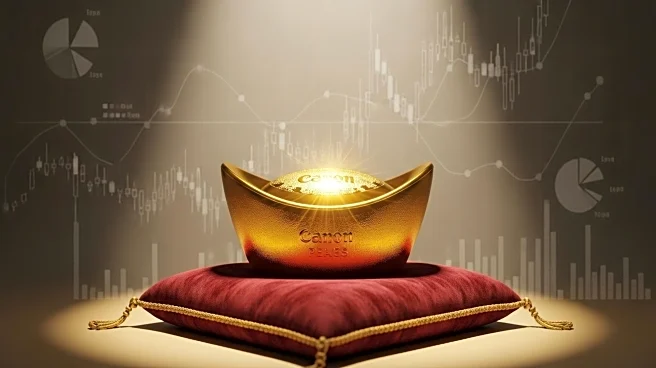What's Happening?
Gold prices are approaching an all-time high, driven by expectations of a U.S. interest rate cut later this month. Spot gold increased by 0.8% to $3,655.77 per ounce, following a record high of $3,673.95. U.S. gold futures for December delivery also rose by 0.3% to $3,694.60. The rise in gold prices is attributed to signs of cooling in the U.S. labor market, which has weakened the dollar, according to Ricardo Evangelista, a senior analyst at ActivTrades. Recent U.S. nonfarm payroll data indicated weakening labor market conditions, reinforcing the likelihood of a rate cut at the Federal Reserve's upcoming policy meeting. The U.S. economy reportedly created 911,000 fewer jobs in the past year than previously estimated, suggesting job growth was stalling before President Trump's tariffs on imports.
Why It's Important?
The potential interest rate cut by the Federal Reserve is significant as it could influence economic growth and monetary policy in the U.S. Lower interest rates typically benefit non-yielding assets like gold, which is seen as a safe haven during economic uncertainty. The outsized job revisions in the U.S. add to the economic uncertainty, further bolstering gold's appeal. Markets are currently pricing in a 92% chance of a 25-basis-point rate cut, with a smaller likelihood of a 50-basis-point cut. This environment has led to a 39% increase in gold prices this year, following a 27% rise in 2024.
What's Next?
The upcoming U.S. producer price inflation data and consumer price inflation reading will be closely monitored for further indications of the Federal Reserve's interest rate trajectory. ANZ Group has raised its year-end gold price forecast to $3,800 per ounce, expecting prices to peak near $4,000 by next June. The continued accumulation by central banks and global uncertainty may sustain the upward trend in gold prices.
Beyond the Headlines
The economic shifts highlighted by the job revisions underscore the role of gold as a safe-haven asset. The broader implications of these economic changes could affect investor confidence and influence global financial markets. The anticipation of interest rate cuts reflects ongoing concerns about economic growth and stability.












